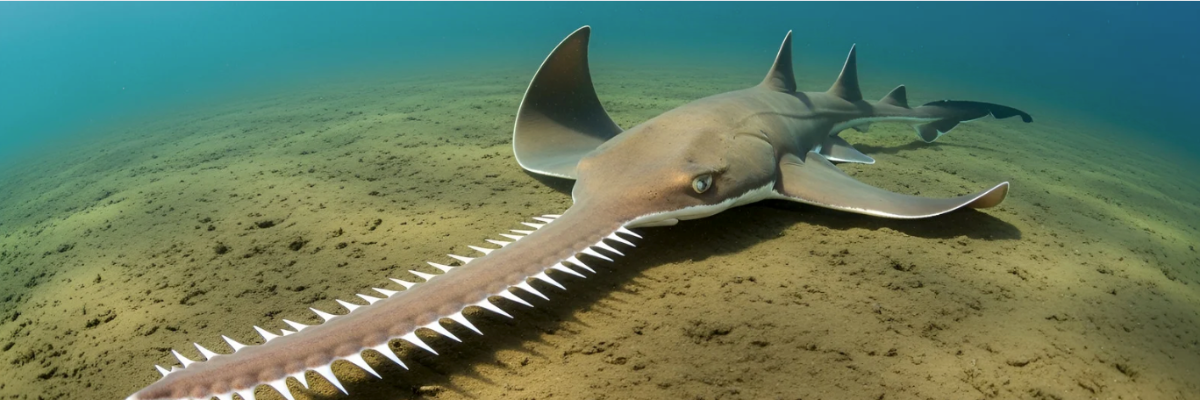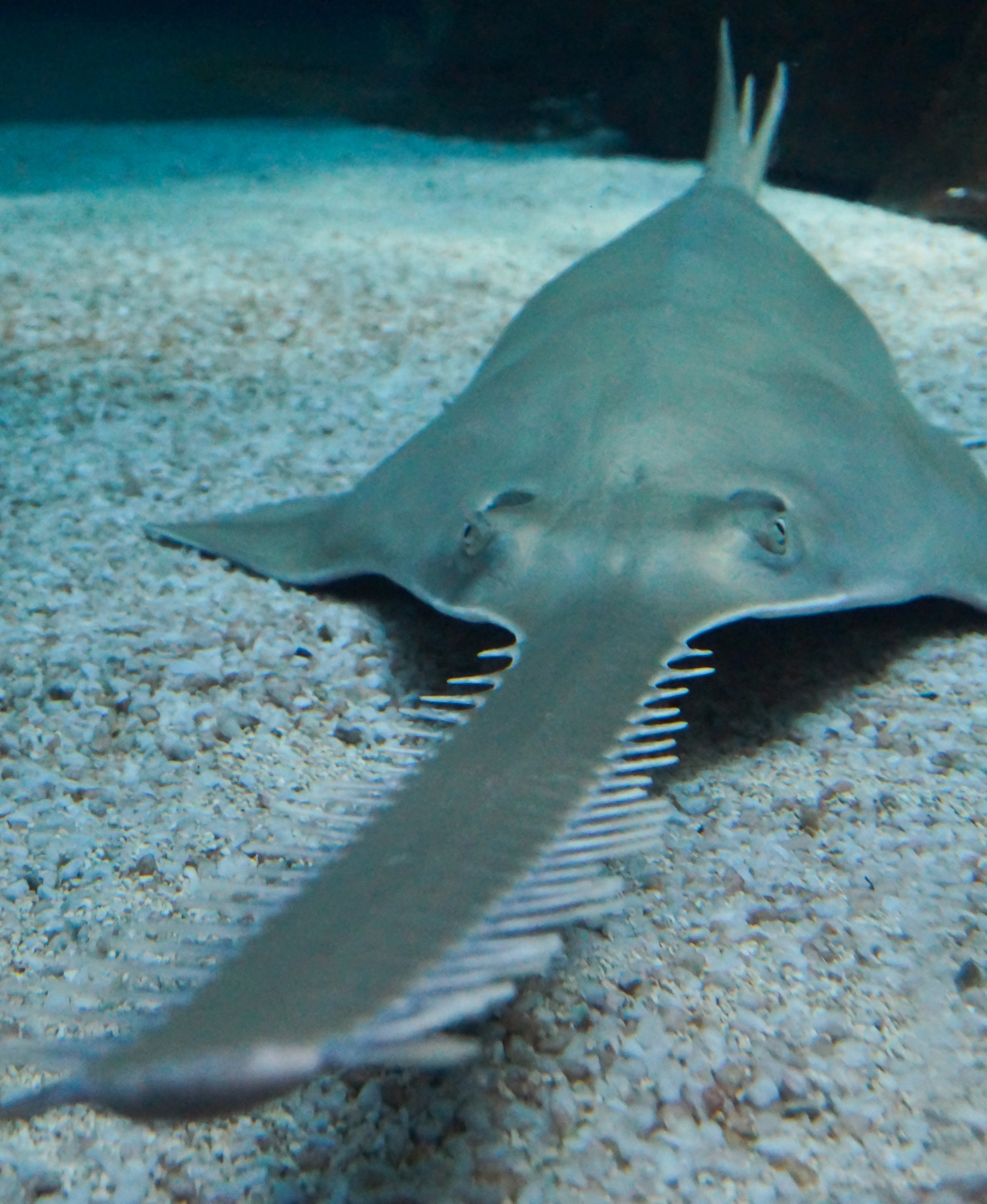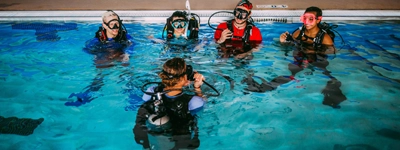
With a long, tooth-lined rostrum that looks like a living chainsaw, the sawfish is one of the ocean’s most extraordinary creatures. Though it might resemble a shark at first glance, the sawfish is actually a type of ray. Adding to the confusion, there’s also a sawshark—a completely different species that shares a similar “saw,” leading many to mix up the two.
Unfortunately, all five species of these remarkable rays are currently listed as Critically Endangered by the International Union for Conservation of Nature (IUCN). Their main threats include bycatch (incidental capture in fishing gear) and habitat loss caused by coastal development and human activities.
At Diventures, we believe the first step to helping any creature is through education and awareness. When divers and non-divers take the time to learn, they can then use their voices to educate others, support research, and advocate for the creatures who can’t.
Sawfish Species
The sawfish family (Pristidae) is divided into two genera or groups (Anoxypristis and Pristis) and consists of five species:
- Dwarf Sawfish
- Green Sawfish
- Narrow Sawfish
- Smalltooth Sawfish
- Largetooth Sawfish

Habitat
Sawfish inhabit warm, shallow coastal waters, estuaries, and river mouths around the world. They prefer sandy or muddy bottoms where they can lie partially buried, waiting for prey to swim by. Depending on the species, they can be found in regions across the Atlantic, Caribbean, and Indo-Pacific.
Unlike many rays, sawfish can tolerate brackish and even freshwater, with some species traveling far upriver. This adaptability once allowed them to thrive in a variety of coastal habitats, but also makes them especially vulnerable to human activity near shorelines.
Body Size
Some species of sawfish can grow over 20 feet long making them some of the longest rays in the ocean. Their flattened bodies and powerful tails allow them to rest along the seafloor while staying ready to swim away quickly if threatened.

Gill Location
Sawfish have gills located on the underside of their bodies, just like other rays. This placement helps distinguish them from sharks, which have gills on their sides. Sawfish are buccal breathers, meaning they can pump water over their gills using their mouths while resting on the ocean floor—allowing them to breathe even when stationary.
Sensory Power
Sawfish have thousands of tiny electroreceptors called the Ampullae of Lorenzini along their saws. These sensors detect the faint electric signals of nearby prey, helping sawfish locate food hidden beneath the ocean floor.
Saw (Rostrum) & Teeth
The sawfish’s defining feature is its long, narrow rostrum — a snout lined with sharp teeth that are uniform in size and spacing. This saw isn’t just for show; it’s an essential tool for both hunting and defense. The sawfish uses these to slash through schools of fish or uncover prey buried in the sand.
Diet & Hunting Behavior
Sawfish are opportunistic hunters that feed on small fish, crustaceans, and other bottom-dwelling creatures. They use their saws to stun or injure prey, then circle back to feed. Despite their intimidating appearance, sawfish pose no threat to humans.

Conservation & Research Efforts
Sawfish play a crucial role in coastal ecosystems, helping regulate smaller fish and invertebrate populations while signaling the overall health of their habitats. Today, researchers and conservationists are working to turn the tide for these critically endangered rays through tagging programs, habitat protection, and community outreach—efforts that are vital for understanding where sawfish live, how they move, and what they need to survive, while guiding policies that protect both the species and the ecosystems they sustain.
One of our Dive Pros experienced firsthand the importance of conservation while interning at Mote Marine Laboratory in 1979. A 14-foot sawfish that had become tangled in a fishing net was brought in for care. The team performed x-rays, ultrasounds, and blood tests before safely releasing it back into the wild. Reflecting on the encounter, he shared:
“Swimming alongside that sawfish was absolutely mesmerizing. It’s hard to find another animal that fires up your imagination like this one does. Seeing such a powerful and mysterious creature up close made me realize just how special our oceans are—and how important it is that we protect them.”
The future of sawfish depends on awareness, education, and collective action. You can make a difference by learning more and supporting organizations dedicated to their protection, like the Sawfish Conservation Society. Their work helps fund research, promote habitat protection, and spread knowledge about these incredible rays.
Even small actions make a difference—by learning and sharing what you know about sawfish, you can help raise awareness and inspire others to protect these incredible creatures. Together, we can ensure these remarkable creatures continue to glide through our oceans for generations to come.
You May Also Like
Diventures Expands with New Dive Shop in Des Moines, Iowa
OMAHA, Neb. (October 7, 2025) – Diventures, the nation’s largest network of scuba and swim centers, today announced the opening of its 19th location in Des Moines, Iowa. This marks the latest expansion of the company's physical presence.The Des Moines store will be...
Meet Lola: The Famous Goliath Grouper
Meet Lola, the famous Goliath grouper known for her playful, “puppy-like” personality and impressive size. Divers visiting Jardines de la Reina in Cuba have had unforgettable encounters with this 400-pound reef giant, observing her curiosity and unique interactions up close. Discover Lola’s story and the role Goliath groupers play in maintaining healthy ocean ecosystems.
No More Chills: Drysuit Diving Tips from Our Expert
Learn everything about drysuit diving from our dive expert, including essential tips on training, selecting the right gear, and staying warm in cold water. Discover how to enjoy longer, more comfortable dives while exploring chilly waters safely, and get expert insights to help you choose and use your drysuit with confidence.


















